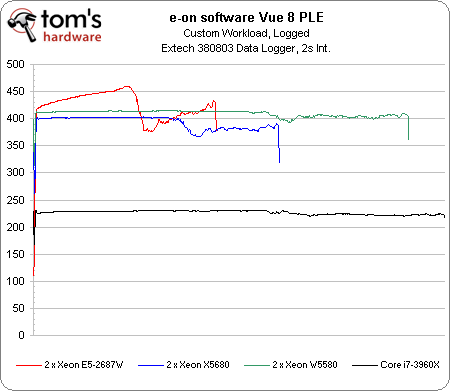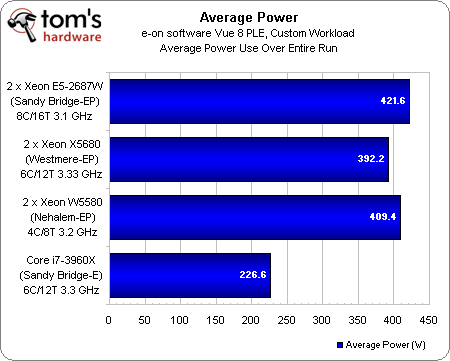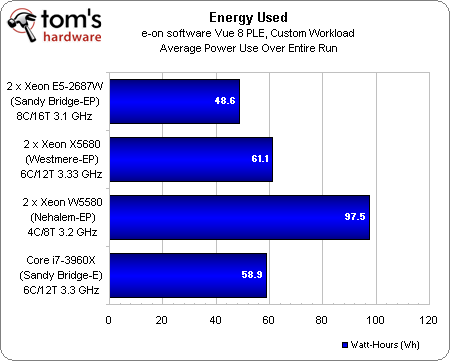Intel Xeon E5-2600: Doing Damage With Two Eight-Core CPUs
Intel's vaunted Sandy Bridge architecture has finally made its way to the company's dual- and quad-socket-capable Xeon processors. We got our hands on a pair of eight-core Xeon E5-2687W CPUs to compare against the older Xeon 5600- and 5500-series chips.
Power Consumption And Efficiency
e-on’s Vue 8 turned out to be the best candidate for measuring system load power because it’s a nice, long workload, and it fully taxes each of these configurations.
We already knew the finishing order from our performance tests. Now we can add to that power use over time, thanks to our Extech logger.
As the line graph suggested, Intel’s Xeon E5-2687Ws average the highest power consumption in this workload (then again, we might have guessed that would be the case, given two CPUs with 150 W TDPs).
Surprisingly, the Xeon W5580s are the second-worst offenders. Remember that Intel switched to 32 nm manufacturing for its Xeon 5600 series, so even though those processors sport an additional two cores each, they’re able to outperform 5500s in threaded apps while using less power.
Naturally, a single Core i7-3960X offers the absolute lowest average power numbers, albeit with the worst performance.
Multiply the average power by the fraction of an hour each configuration took to finish its rendering task and you end up with energy use in Watt-hours.
High power use and mediocre performance really hurt the old Xeon 5500s here. In comparison, the 5600s are much more attractive (though they use marginally more energy than a single Core i7-3960X, which is slow but draws a lot less from the wall).
Get Tom's Hardware's best news and in-depth reviews, straight to your inbox.
The real winners are Intel’s Xeon E5s, though. Despite averaging the highest power consumption, stellar performance under a full load translates to the lowest energy use.
Current page: Power Consumption And Efficiency
Prev Page Percent Faster: Xeon E5s Vs. Xeon 5600s Next Page Xeon E5: Respectable Performance Boost, Bigger Efficiency Gain-
CaedenV My brain cannot comprehend what CS5 would look like with this combined with a 1TB R4 drive, and the GTX680 version of the Quatro would look like... and I am sure my wallet cannot!Reply
Great article! I was not expecting my mind to be blown away today, and it was :) -
dalethepcman No gaming benchmarks? I know this is a high workstation / mid server build, but you know some of the boutiques will make a gaming rig out of any platform. Just out of curiosity, I would have liked to see 2x7970 or 2x580 and a few gaming benchmarks thrown in. :)Reply -
willard dalethepcmanNo gaming benchmarks? I know this is a high workstation / mid server build, but you know some of the boutiques will make a gaming rig out of any platform. Just out of curiosity, I would have liked to see 2x7970 or 2x580 and a few gaming benchmarks thrown in.I'd be really surprised to see these in gaming machines, even in the high end boutiques. That's a $2k processor they reviewed, and basically all it offers over the $1k SB-E chip (for gamers) is an extra pair of cores, which games can't make use of.Reply -
reclusiveorc I wonder how fast TempEncode would chew thru transcoding avi/wmv files to mp3/mp4Reply -
willard esreverwhy aren't AMD cpus tested too? I wouldn't mind seeing how 2x interlagos stacks up.Anandtech benched those next to the new Xeons. Went about as well as Bulldozer vs. Sandy Bridge.Reply
http://www.anandtech.com/show/5553/the-xeon-e52600-dual-sandybridge-for-servers/6 -
cangelini esreverwhy aren't AMD cpus tested too? I wouldn't mind seeing how 2x interlagos stacks up.Mentioned on the test page--I've invited them to send hardware and they haven't moved on it yet.Reply -
willard cangeliniMentioned on the test page--I've invited them to send hardware and they haven't moved on it yet.I would guess that's because Interlagos is garbage compared to the new Xeons and they know it. I don't think they're terribly eager for the front page of Tom's Hardware to show the low end Xeon's beating the best Interlagos has to offer.Reply -
Onus What, or who, was the target? Are there military applications for this weapon?Reply
Sorry, vote me down all you like, but the title was just silly.



